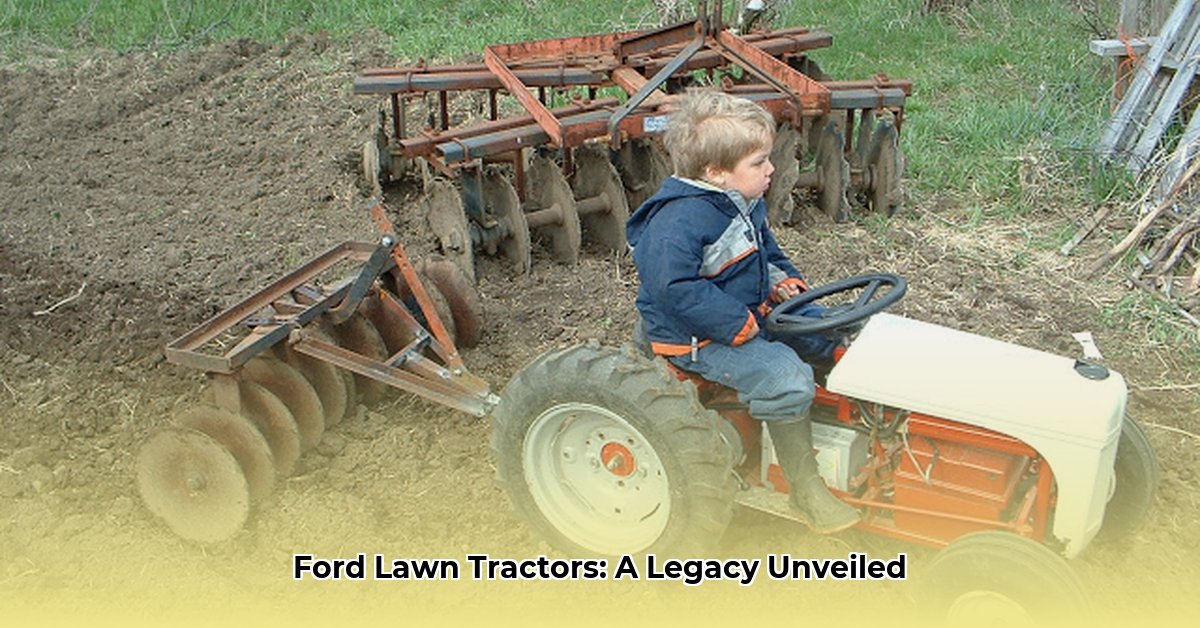
A Legacy Forged in Partnerships
The story of Ford lawn and garden tractors isn't a tale of sole proprietorship; it's a compelling case study in strategic partnerships and brand leverage. Rather than establishing its own manufacturing facilities, Ford shrewdly collaborated with established Original Equipment Manufacturers (OEMs) like Jacobsen, Gilson, and Toro. This approach, leveraging existing expertise, propelled Ford into the lawn and garden equipment market with remarkable speed and success. Imagine the surprise—and the instant recognition—when the iconic Ford name appeared on lawn tractors in local hardware stores. For more detailed specifications on some models, check out this helpful resource: Ford Tractor Specs.
This OEM strategy wasn't merely a short-term solution. While precise historical sales figures remain elusive (a fascinating area for future research), the impact of Ford's branding on existing, high-quality products is undeniable. The marketing was simple and effective: "It's a Ford; it's got to be good." This resonated deeply with consumers, tapping into the inherent trust associated with the Ford name and its reputation for reliability. The success highlights the power of leveraging established brand recognition to bypass the considerable time and financial investment required to build a new manufacturing infrastructure from scratch. This approach exemplifies a calculated gamble, and a smart one at that.
This strategy offers valuable lessons for contemporary businesses. It demonstrates that a powerful brand can often compensate for a lack of direct manufacturing experience, highlighting a potent synergy between established brand reputation and trusted OEM partnerships. This intelligent outsourcing model represents an efficient strategy for market entry and rapid expansion, maximizing results while minimizing risk and financial outlay. It provides a powerful example of the significant value of strategic brand partnerships.
However, the story doesn't conclude with unwavering success. In 1988, Ford divested its agricultural equipment division, including the lawn tractor line, to Fiat. This subsequent integration into New Holland marked a significant shift, illustrating the influence of larger economic forces and corporate consolidation on even the most successful products. This transition doesn't necessarily reflect on the performance or popularity of the Ford lawn tractors themselves, but instead highlights the impact of wider industry trends and the inherent vulnerabilities of OEM strategies reliant on the strategic decisions of larger corporations.
Despite this shift, the legacy of Ford lawn and garden tractors endures. Today, these machines hold significant appeal for collectors and enthusiasts. Their historical significance, and even the scarcity of certain models, contributes to their increasing value within the collector's market. For many, owning a classic Ford lawn tractor transcends mere functionality; it becomes a tangible piece of history. The tractors stand as a testament to the power of strategic partnerships and the long-lasting appeal of a powerful brand. How many lawn tractors can boast a legacy like that?
The Enduring Appeal: Valuing a Vintage Ford Lawn Tractor
The task of valuing a vintage Ford lawn tractor, such as the popular LGT 125 (produced between 1977 and 1983), isn't a straightforward one. Resources like Kelley Blue Book typically don't include vintage lawn tractors in their databases, making the process more involved and requiring a multi-faceted approach. This lack of centralized valuation data is a testament to the niche nature of the collector's market for vintage lawn tractors.
A Step-by-Step Valuation Guide
Condition Assessment: A meticulously restored tractor is worth significantly more than one in need of repair. Meticulous documentation, including photographs of any missing parts, is crucial. High-quality photography helps establish an objective assessment of condition.
Comparable Market Research: Thorough research of online marketplaces (e.g., eBay, specialized forums, classic tractor auctions) is essential. Focus on completed sales – not just listed items – of similar Ford LGT 125 models. Note the condition and any unique features of comparable units.
Professional Appraisal: Seeking appraisals from classic tractor dealers provides valuable insights into market trends and permits a formal valuation based on expert experience. This investment proves particularly useful for serious sellers.
Restoration Cost Consideration: If the tractor has been restored, the total cost (parts and labor) establishes a minimum value. Detailed documentation of these expenses further strengthens the valuation process.
Regional Market Analysis: Demand for vintage tractors exhibits regional variation. A highly sought-after model in one region might fetch a lower price in another. Awareness of local collector communities and their influence on pricing is essential.
The importance of meticulous documentation cannot be overstated. Photographs, repair receipts, and any historical information significantly increase a tractor's value, contributing to its overall desirability for discerning collectors.
Key Factors Influencing Value:
| Factor | Impact on Value |
|---|---|
| Condition | Higher condition correlates with higher value. |
| Rarity | Rare models command higher prices. |
| Restoration History | Comprehensive documentation enhances value. |
| Market Demand (Local) | Regional demand influences the pricing significantly. |
| Completeness | Missing parts (e.g., hubcaps) decrease value. |
Ford's Green Legacy: A Lasting Impression
Ford’s foray into the lawn and garden equipment market wasn’t accidental; it was a strategic move leveraging their core engineering expertise and recognizing the growing demand for reliable yard tools in the burgeoning post-war suburban landscape. It represented a smart application of automotive knowledge on a smaller, more localized scale. This wasn't just about selling tractors; it was about participating in and contributing to the American dream of homeownership. The lasting legacy of these machines lies not only in their functionality but also in their contribution to the history of American suburban landscapes. The Ford LGT 125, for example, stands as a fine example of this strategy, reflecting the technology and desires of its era. The success of this venture, however short-lived from a manufacturing standpoint, is a lasting testament to the power of insightful brand extension, even into seemingly unrelated markets.